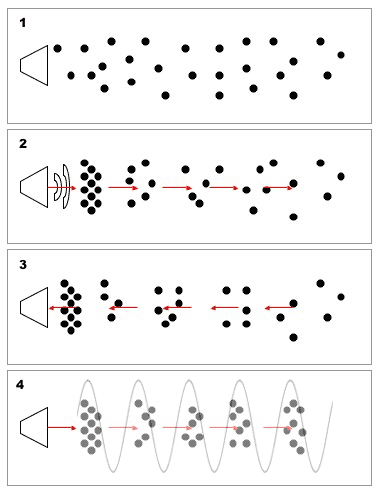what is sound?
Simple as it is, we will start from the very basic question, and this is how the literature defines Sound:
"vibrations that travel through the air or another medium and can be heard when they reach a person's or animal's ear. " [1]
"[...] a mechanical disturbance of the medium, which may be air, or a solid, liquid or other gas." [2]
Which sounds perhaps more complicated than it is. What can be derived from these definitions is that sound only exist because there is something it can travel in, the medium. Without air, or whatever medium we happen to use, we would not hear a thing. Why? Because all we can hear, being it a piece of music, words or noises, is all thanks to the movements of our eardrums, stimulated by some air particles moved by a vibrating object. More will be said about different kind of vibrations and about human hearing as well.
No movements of any kind would be transmitted to us in a vacuum, no matter how strong the originating vibrations are. Different mediums have different physical properties, so we will refer to air only from now on; and actually the term "air" is a little too generic for precise calculations, but it will do for now.
Thanks to the elastic properties of air, when stimulated by a vibration its molecules go through a cyclic process of compression and decompression, as shown:
[1] Air particles in a rest state are usually evenly distributed in space, tending to use all the space available (like any gas).
[2] A vibrating object (like the piston of a loudspeaker) would push the immediately closest air particles, creating an area of compression. The 'pushed' air particles pass the disturbance to the adjacent particles, and so on.
[3] Air is an elastic medium, so after being pushed, molecules will naturally return to their original position, leaving a zone of rarefaction that will attract the adjacent molecules in the same direction. The movement will continue to pass with a progressive fade until the kinetic energy of the particles is completely dissipated.
[4] These cyclic movements are often represented by a waveform.
The sound shown above is represented by a very particular waveform: a sine. This waveform shows a perfectly regular cyclic succession of compression and rarefaction stages which make the sound represented what is commonly called a pure tone.
In the next chapter we will examine some of the main characteristics of a sound wave.
---
[1] New Oxford American Dictionary, 2005
[2] Angus, 2001, p. 1
"vibrations that travel through the air or another medium and can be heard when they reach a person's or animal's ear. " [1]
"[...] a mechanical disturbance of the medium, which may be air, or a solid, liquid or other gas." [2]
Which sounds perhaps more complicated than it is. What can be derived from these definitions is that sound only exist because there is something it can travel in, the medium. Without air, or whatever medium we happen to use, we would not hear a thing. Why? Because all we can hear, being it a piece of music, words or noises, is all thanks to the movements of our eardrums, stimulated by some air particles moved by a vibrating object. More will be said about different kind of vibrations and about human hearing as well.
No movements of any kind would be transmitted to us in a vacuum, no matter how strong the originating vibrations are. Different mediums have different physical properties, so we will refer to air only from now on; and actually the term "air" is a little too generic for precise calculations, but it will do for now.
Thanks to the elastic properties of air, when stimulated by a vibration its molecules go through a cyclic process of compression and decompression, as shown:

[1] Air particles in a rest state are usually evenly distributed in space, tending to use all the space available (like any gas).
[2] A vibrating object (like the piston of a loudspeaker) would push the immediately closest air particles, creating an area of compression. The 'pushed' air particles pass the disturbance to the adjacent particles, and so on.
[3] Air is an elastic medium, so after being pushed, molecules will naturally return to their original position, leaving a zone of rarefaction that will attract the adjacent molecules in the same direction. The movement will continue to pass with a progressive fade until the kinetic energy of the particles is completely dissipated.
[4] These cyclic movements are often represented by a waveform.
The sound shown above is represented by a very particular waveform: a sine. This waveform shows a perfectly regular cyclic succession of compression and rarefaction stages which make the sound represented what is commonly called a pure tone.
In the next chapter we will examine some of the main characteristics of a sound wave.
---
[1] New Oxford American Dictionary, 2005
[2] Angus, 2001, p. 1
